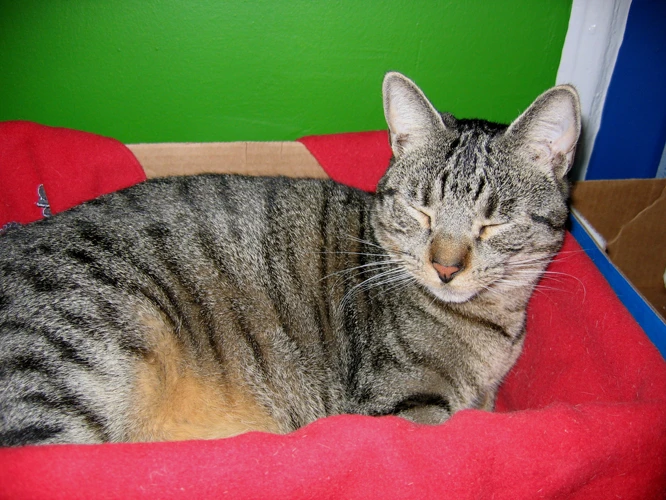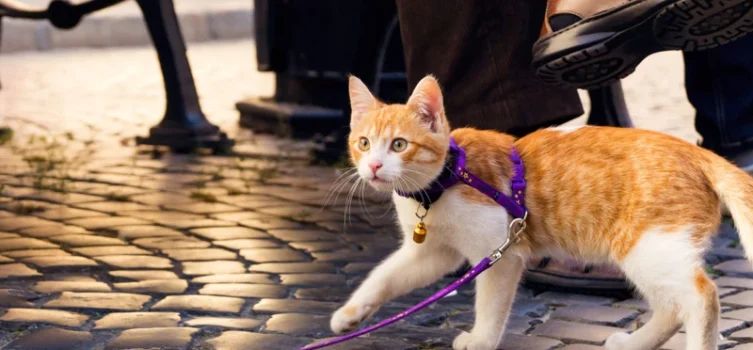Have you recently welcomed a California Spangled kitten into your home and want to start leash training? While some cats may be hesitant to take to a leash, leash training can provide a great way to safely explore the outdoors with your feline friend. However, before diving into the leash training process, some preparation is required. In this article, we’ll cover some tips and tricks for getting started with leash training, as well as troubleshooting common issues that may arise along the way. So, grab your kitty and let’s dive in!
Getting Ready for Leash Training

As the proud owner of a California Spangled Kitten, you may be wondering how to get started with leash training. While this process can take time and patience, it’s an excellent way to bond with your kitty and give them the exercise they need. Before we dive into the step-by-step process, let’s talk about what you’ll need to get ready for leash training. From choosing the right collar and leash to practicing walking on a harness, the preparation phase is essential for success. So, grab a pen and paper, and let’s get started! If you want to learn more about the benefits of leash training for your California Spangled Cat, consider checking out our article on the subject.
Choose a Collar and Leash
Choosing the right collar and leash is crucial for a successful leash training experience with your California Spangled kitten. There are many types of collars available on the market, but not all of them are suitable for kittens. It’s important to consider the material, size, and fit when selecting a collar.
One popular option for kittens is a breakaway collar, which is designed to open when the collar is tugged, preventing injury to your kitten. Another option is a safety collar with an elastic insert, which allows for a comfortable and safe fit. It’s important to avoid using choke chains, prong collars, or shock collars as they can cause physical harm and generate fear in your feline friend.
When it comes to selecting a leash, a lightweight and sturdy nylon leash is a great option. Choose a leash that is at least 6 feet long to give your kitten enough room to explore while remaining close to you.
To make things easier for your kitten, consider a harness instead of a collar. A well-fitting harness provides more support and allows for better control, especially for kittens who are still adjusting to leash training. There are many types of harnesses available, but a vest-style harness with adjustable straps works well for kittens and prevents any choking or strain on their neck.
When choosing a collar and leash, keep in mind the size and comfort of your California Spangled kitten. A properly fitting collar and harness should be snug but not too tight, and the leash should be lightweight enough for your kitten to wear without feeling weighed down.
For more information on leashes and other harness options, see our article on Cali Spangled Cat Leashes or our article on Cali Spangled Leash. It’s important to understand proper leash training techniques before beginning, so be sure to read our guide on Cali Spangled Leash Training and avoid common mistakes discussed in our article on Leash Training California Spangled: Mistakes to Avoid.
Get Your Kitten Used to the Collar
Getting your California Spangled kitten used to a collar is an important first step in leash training. Here are some tips to help your kitten adjust to wearing a collar:
- Start early: Ideally, you should start getting your kitten used to a collar when they’re just a few weeks old. This will make the process easier and more successful.
- Choose the right collar: Make sure the collar you choose is comfortable and fits your kitten properly. Look for a collar made of soft material that won’t irritate their skin. You should be able to fit two fingers comfortably between the collar and your kitten’s neck.
- Introduce the collar gradually: At first, let your kitten wear the collar for short periods of time and under supervision. You can gradually increase the amount of time they wear the collar as they get used to it.
- Use positive reinforcement: When your kitten is wearing the collar, give them plenty of love and treats. This will help them associate the collar with positive experiences.
- Check the collar regularly: Make sure the collar is not too tight or too loose, and that it hasn’t become caught on anything. Check the collar regularly to ensure it’s still in good condition.
By following these tips, you can help your California Spangled kitten get used to wearing a collar and prepare them for leash training. Remember to be patient and consistent, and always use positive reinforcement to encourage good behavior.
Practice Walking on a Harness
A harness is a safer option than a collar when it comes to walking your California Spangled kitten on a leash. The harness distributes the pressure around the body, reducing the chance of injury.
Here’s how to practice walking on a harness:
| Step 1: | Let your kitten get used to the harness on its own. Leave it out as a toy or place it near the food or water bowl. This way, your kitten will begin to associate the harness with positive experiences. |
| Step 2: | Once your kitten is comfortable with the harness, put it on for short periods while indoors. Allow your kitten to move around freely and explore its surroundings while wearing the harness. This will help your kitten get used to the feeling of wearing the harness. |
| Step 3: | Gradually increase the time that your kitten spends wearing the harness. During this time, you can play with your kitten or offer treats to keep it distracted and happy. |
| Step 4: | After your kitten is comfortable wearing the harness for extended periods, you can attach the leash to the harness indoors and let your kitten drag it around for a short time. Be sure to supervise your kitten at all times during this step. |
It’s important to note that you should never leave your kitten unattended while wearing the harness or with the leash attached. Once your kitten is comfortable with the harness and leash indoors, you can move on to leash training outdoors.
Starting Leash Training with Your Kitten

After preparing your California Spangled kitten for leash training, it’s time to start the actual training process. While it can be exciting to see your kitten exploring the world outside for the first time, it’s important to start slow and be patient. This will help ensure that your kitten feels comfortable and safe. In this section, we’ll cover some tips for starting leash training with your kitten. Remember, every kitten is different, so take your time and adjust the training to suit your kitten’s needs.
Start Indoors
When starting leash training with your California Spangled Kitten, it is important to start indoors before moving to outdoor environments. This allows your kitten to become familiar with the sensation of wearing a collar and leash in a controlled environment.
Here are some general tips for starting leash training indoors:
| Tip 1: | Choose a quiet, distraction-free room to start in. |
| Tip 2: | Allow your kitten to sniff and explore the collar and leash before putting them on. |
| Tip 3: | Attach the leash to the collar and let your kitten drag it around the room to get used to the feeling of being tethered. |
| Tip 4: | Encourage your kitten to walk with you using treats as rewards. |
| Tip 5: | Teach basic commands such as “come” and “stay” to reinforce good behavior. |
Starting indoors creates a safe and controlled environment for your kitten to learn and get used to the sensation of wearing a collar and being tethered to a leash. By introducing your kitty to the leash and collar in small, positive experiences, you can build up good habits that will carry through to outdoor leash training.
Use Treats as Rewards
One of the most effective and humane ways to train your California Spangled kitten to walk on a leash is to use treats as rewards. Positive reinforcement will create a positive association with the leash and harness, making the training process significantly easier.
Here are some tips for using treats as rewards during leash training:
- Choose the Right Treat: Make sure to choose a treat that your kitten loves and is willing to work for. Small pieces of soft, moist treats are perfect for leash training, as they are easy to eat quickly and won’t distract your kitten for too long.
- Timing is Everything: Be sure to offer your kitten the treat immediately after they exhibit the desired behavior, such as walking calmly on the leash. This will reinforce the connection between the behavior and the reward.
- Keep the Treats Close: Keep the treats in your pocket or in a treat pouch attached to your waistband. This will allow you to offer the rewards quickly and easily without breaking your stride or interrupting the training session.
- Vary the Treats: To keep your kitten interested and motivated, vary the type of treat you offer throughout the training sessions. You can also offer verbal praise, petting, or a favorite toy as a reward to add variety.
- Never Punish: Remember that punishing your kitten for misbehaving during leash training will only create stress and a negative association with the process. Instead, be patient and use positive reinforcement to encourage good behavior and progress.
Using treats as rewards during leash training will make the experience more enjoyable and effective for both you and your California Spangled kitten. Remember to be consistent and patient, and over time your kitten will become a pro at walking on a leash.
Teach Basic Commands
Learning basic commands is an essential part of leash training your California Spangled kitten. These commands will help them understand what is expected of them during outdoor walks and make the training process smoother and more efficient. Here are some essential commands you should teach your kitten:
| Command | Description |
|---|---|
| Walk | Teach your kitten to walk calmly beside you. Use treats to reward good behavior, and stop walking if they start pulling on the leash |
| Stop | Teach your kitten to stop when you stop walking. This command will help avoid tripping on the leash, and keep your kitten safe |
| Sit | Teach your kitten to sit on command. This command is useful for stopping your kitten from running off or crossing the street without permission |
| Come | Teach your kitten to come to you when you call their name. This command can be useful if your kitten gets loose or runs away during a walk |
When teaching these commands, use positive reinforcement and repetition. Use treats or praise to reinforce good behavior, and practice each command regularly until your kitten has mastered it before moving on to the next one. Remember to keep training sessions short and enjoyable, and never force your kitten to do anything they don’t want to do. With patience and consistency, your California Spangled kitten will become a well-behaved and happy walking companion.
Gradually Increase Time and Distance
Once your California Spangled Kitten has become comfortable walking on a leash indoors, it’s time to gradually increase the duration and distance of your walks. This process needs to be done slowly and steadily to avoid overwhelming your kitten or causing them any stress.
Here are some tips for gradually increasing the time and distance of your kitten’s leash training:
- Start by adding a few extra minutes to your walks each day. You can gradually work up to a longer walk over time.
- As you lengthen the time of your walks, gradually increase the distance as well. Your kitten needs to be comfortable with the slow increase in distance at their own pace.
- Be patient and observant. Signs of fatigue or agitation are your cue to pause or stop for the day. Overdoing it can undo all of your previous good progress!
- Try changing the route of your walks now and then to keep things fresh for your kitten.
- Keep treats handy so that you can reward your kitten for good behavior during the walks. This will help to reinforce their good training behavior and make the experience more enjoyable for them.
By gradually increasing the time and distance of your kitten’s leash training, you can foster their confidence while ensuring they develop healthy walking habits. However, remember to listen to your kitten during this process – slow and steady wins the race!
Troubleshooting Common Leash Training Issues
While leash training your California Spangled kitten can be an exciting experience, there may be some common issues that arise during the process. These issues can include pulling on the leash or fearful behavior, which can make the training difficult for both you and your kitten. However, with the right techniques and tools, you can overcome these challenges and continue making progress towards successful leash training. Let’s explore some troubleshooting methods for common leash training issues.
Pulling on the Leash
It’s common for kittens to pull on their leash during walks, but it’s important to train them to walk calmly by your side. If your California Spangled Kitten starts pulling on the leash, here are some tips to address the issue:
- Stop and Stand Firm: When your kitten starts pulling, stop walking and stand still. This teaches them that pulling is not the way to get where they want to go.
- Change Directions: If your kitten continues to pull after standing still, quickly change directions. This helps reinforce that you are in control of the walk, not them.
- Avoid Tugging or Jerking: Pulling back or jerking the leash can hurt your kitten and make them fearful. Instead, use a gentle pull to redirect them.
- Encourage Walking by Your Side: Praise and reward your kitten when they walk calmly by your side. Use treats, toys or verbal praise to reinforce good behavior.
- Use a Shorter Leash: A shorter leash gives you more control and can help prevent pulling. Try a 4-6 foot leash for better management.
- Avoid Using Retractable Leashes: Retractable leashes can encourage pulling and make it harder to control your kitten. Stick to a traditional leash to help with training.
Remember that leash training takes time and patience, but with consistency and positive reinforcement, your California Spangled Kitten will learn to walk calmly by your side!
Fearful or Resistant Behavior
If your California Spangled kitten is exhibiting fearful or resistant behavior during leash training, it’s important to address the issue promptly to prevent the development of negative associations with the training experience. Here are some tips and strategies to help you work through these challenges:
1. Be Patient and Understanding. Remember, leash training can be a new and overwhelming experience for your kitten. It’s important to be patient and understanding, and not to force your kitten to participate in training if they seem especially hesitant or distressed.
2. Start Slowly and Gradually. When working with a fearful kitten, it’s important to start with short training sessions in a quiet and familiar environment. Gradually increase the length and difficulty of each session as your kitten becomes more comfortable and confident.
3. Use Treats and Positive Reinforcement. Positive reinforcement is an effective way to encourage your kitten to participate in training. Use treats and praise to reward your kitten for positive behavior during training, and to help build their confidence and trust in the training process.
4. Use Distraction and Play Strategies. Sometimes, a kitten’s fear or resistance may be related to anxiety or nervousness. Using distraction and play strategies, like toys and games, can help your kitten feel more relaxed and engaged during training.
5. Consider Professional Assistance. If your kitten is exhibiting severe fearful or resistant behavior during leash training, it may be helpful to seek the assistance of a professional animal behaviorist. They can provide expert guidance and support to help you work through these challenges and develop a successful training plan for your kitten.
By following these tips and strategies, you can help your California Spangled kitten overcome their fears and become a confident and successful leash walker.
Conclusion
After following the tips and steps outlined in this article, you should now be well on your way to successfully leash training your California Spangled kitten. Remember that leash training is a gradual process and requires patience, persistence, and positive reinforcement.
Always prioritize the safety and comfort of your kitten – don’t rush into long walks before your kitten is ready. Starting with short indoor sessions and building up to longer outdoor walks will help ensure that your kitten is not overwhelmed or stressed.
Choosing the right equipment is important – a harness is generally recommended over a collar for leash training, as it provides more support and is less likely to cause injury. Adjust the harness to fit snugly but not too tightly, and make sure the leash is attached securely.
Positive reinforcement is key – reward your kitten with treats and praise whenever they successfully follow your commands. This will encourage them to continue behaving well on the leash.
Be prepared for setbacks and challenges – some kittens may take longer to adjust to leash training, and may exhibit behaviors such as pulling or resisting the leash. With patience and consistency, however, even the most stubborn kitten can eventually become comfortable with walking on a leash.
Overall, with a bit of effort and dedication, you can enjoy many wonderful outdoor adventures with your California Spangled kitten by your side. Good luck with your leash training journey!
Frequently Asked Questions
Can all cats be leash trained?
Technically, any cat can be leash trained, but some breeds may be more reluctant or difficult to train.
At what age can I start leash training my California Spangled kitten?
It’s best to start leash training when your kitten is around 5-6 months old and has received their vaccinations.
What type of collar and leash should I use for leash training?
A comfortable, well-fitting harness and a lightweight leash is best for leash training cats. Avoid using collars that may put pressure on the neck.
How can I get my kitten used to wearing a collar?
Start by introducing the collar gradually, letting your kitten sniff and touch it before putting it on. Then, leave the collar on for short periods of time, gradually increasing the duration.
How do I teach my kitten to walk on a harness?
Start by letting your kitten sniff and explore the harness, then put it on in the house for short periods of time. Gradually increase the time wearing the harness and introduce walking on a leash indoors before taking it outside.
What type of treats should I use for leash training?
Use small, soft treats that your kitten enjoys, such as pieces of cooked chicken or commercial cat treats. Avoid using treats that are too large or hard for your kitten to eat quickly.
What basic commands should I teach my kitten for leash training?
Start with simple commands like “come” and “stay”, and gradually introduce more complex commands like “heel” or “stop.”
What should I do if my kitten pulls on the leash during walks?
Stop walking and wait for your kitten to calm down before continuing. Avoid yanking or pulling on the leash, as this may reinforce the bad behavior.
What if my kitten is afraid of wearing a harness or walking on a leash?
Start by introducing the harness and leash gradually, making the experience positive with treats and encouragement. If your kitten is still fearful, consult with a professional trainer or behaviorist.
How long does it take to fully leash train my kitten?
Leash training may take several weeks or months of consistent training and practice. Every kitten is different, so be patient and take your time with the process.







